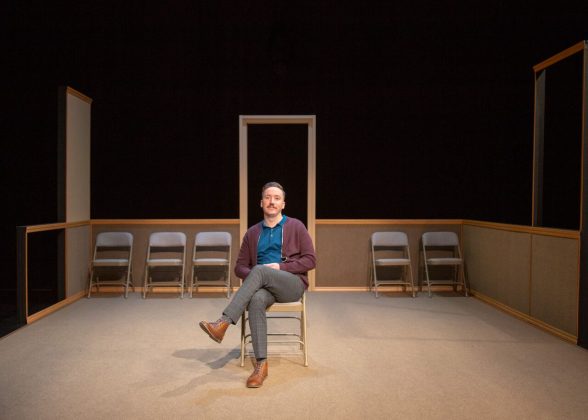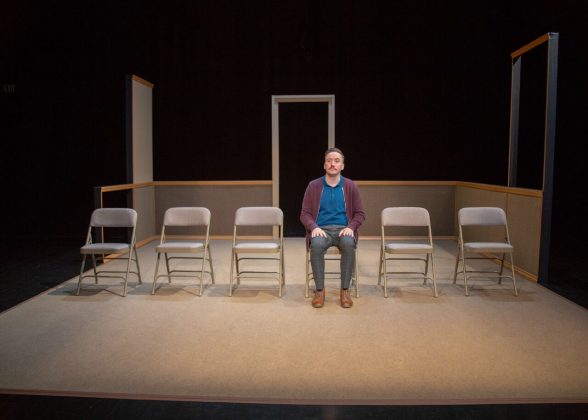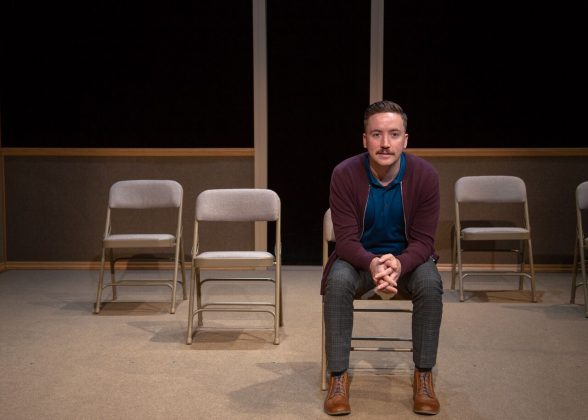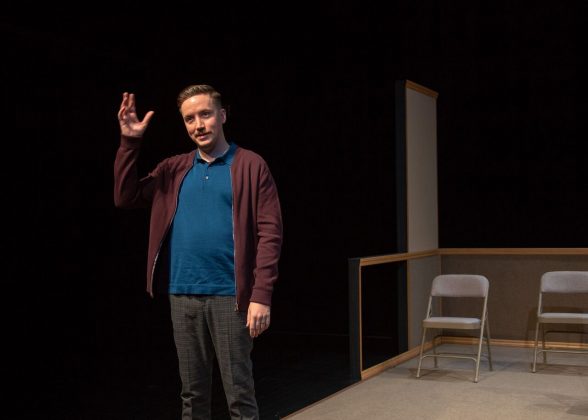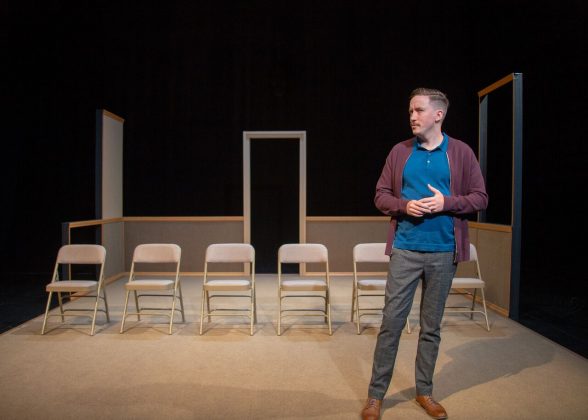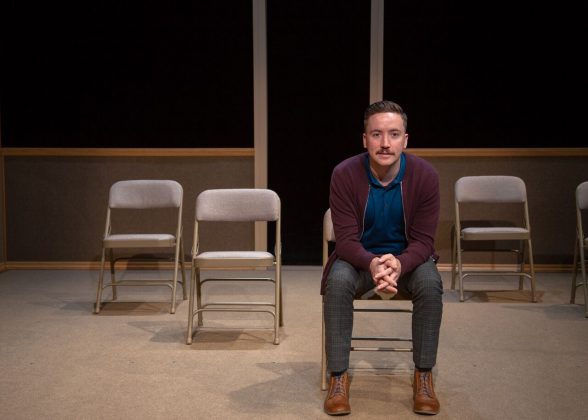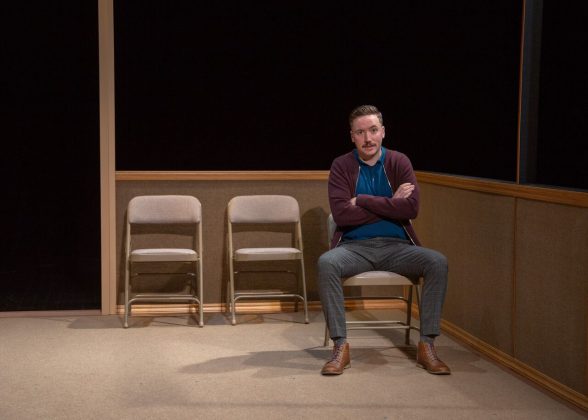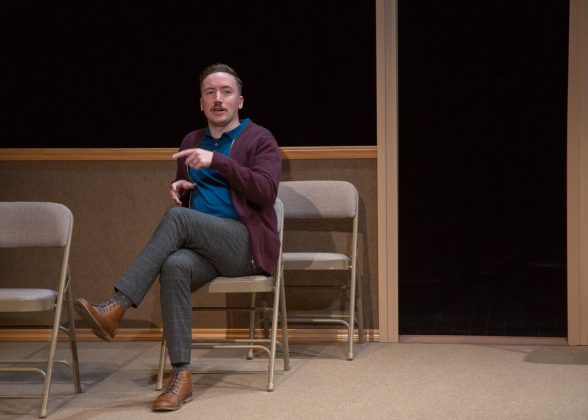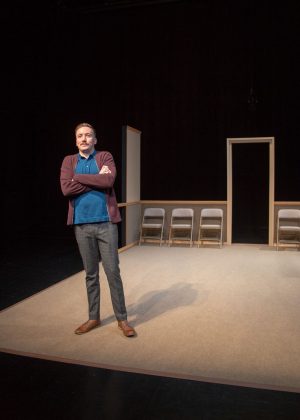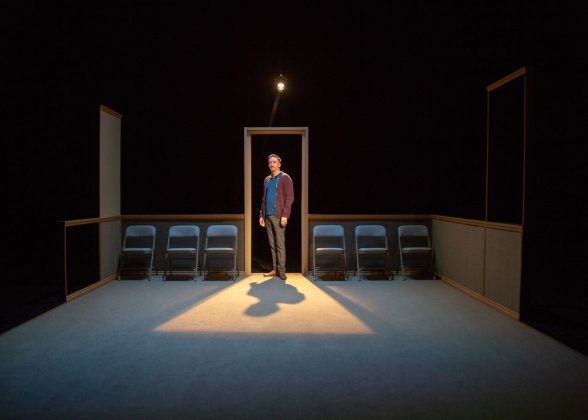SALT LAKE CITY, Utah, Oct. 22, 2018 (Gephardt Daily) — Plan-B Theatre’s first show of the season, a world premiere, tells the story of a gay member of The Church of Jesus-Christ of Latter Day Saints, facing possible excommunication in a “court of love” a week after marrying the man of his dreams.
Playwright Matthew Greene, who also wrote “Adam & Steve and the Empty Sea,” produced by Plan-B in 2013, writes in a blog post for the company that this new show is his most autobiographical:
“I spent my days playing the perfect Mormon, slipping that ill-fitting costume on over the self I’d learned to loathe and trying my best to walk a path that was, frankly, killing me. My solace in those dark days was the pen and the page.”
In the one-man show, actor Austin Archer initially appears as Curt Brown, who has been called before a disciplinary committee for possible punishment. Archer then begins to take on the personas of the men whose job it is to judge Brown.
The great success of “Good Standing” is that the playwright, actor and director work in perfect harmony to create a piece that is searingly memorable.
Archer’s performance — surprisingly, his first for the company — is nothing less than astonishing. He portrays not only Curt, but also 15 other characters: the three members of the presidency of his stake and the 12 members of a high council convened to decide his fate.
He and Jerry Rapier, the director, made the understated but effective choice that when Archer is Curt, he stands, and when he sits, he becomes one of the other characters. But how on earth do you differentiate between all the men? As Archer points out in a blog post on the Plan-B website: “A difficulty that’s a bit more specific to this show is finding particular differentiations between my characters who are almost all middle-aged white Mormon men from Utah … if several of my characters start with the same basic archetype, same basic speech patterns, same beliefs, same sort of look, how do I go about making sure the audience knows the difference between them?”
Well the answer to that is that Archer somehow internalizes each character so the differences between them emanate from the inside. The men have slightly different cadences; some have slightly more expressive hand gestures, or barely any at all. And yet very quickly I could tell precisely who was who. It’s as if Archer is acting for film, and yet somehow he makes his performance fill the space completely.
I also really appreciated that Greene’s play does not come across as a deliberate attempt to bash the Church. I have seen pieces that deal with subjects such as this where the LDS characters come across only as bitter archetypes. Writing such one-dimensional characters is just rather dull for an audience member. But the beauty of this play is that Greene configures each man as having very different feelings about the case, as such, a rainbow of emotions.
“In the fictional worlds I crafted, nothing could stop me from exploring the tantalizing gray areas,” Greene writes in his blog post.
Even though some of the men are extremely conservative, the way the play is written, directed, and acted, even if we disagree with the opinions we hear, there is a respect that is maintained for each character, and Greene also makes it clear that the men’s opinions often cause them personal pain. I haven’t seen a play before that deals with this most thorny of topics but also paints all the characters fairly and without rancor. There is also a twist toward the end that I absolutely did not see coming and is gut-wrenching.
I also appreciated that the production elements are kept simple, which only serves to highlight the veritable juggernaut of emotions packed into the 75 minutes of the show. The set design by Keven Myhre depicts a room that could not be starker, beiger (if that’s a word) and less welcoming — as Curt says right at the beginning of the play, it is also literally cold. The lighting design by Matthew Taylor is equally minimal and there’s not even a costume designer credited since Curt only wears one outfit.
After the Utah run, the show is going to New York, playing at United Solo on Nov. 4. Plan-B should be very proud of the production. I have the feeling that it is going to be bigger than this initial run. And for that reason, as well as its timeliness in today’s world, I highly recommend it.
“Good Standing” runs through Oct. 28 at the Rose Wagner, 138 W. Broadway (300 South). The show plays Thursday, Friday and Saturday at 8 p.m., with additional performances Saturday at 4 p.m. and Sunday at 2 p.m. Tickets are $22 and $10 for students, at 801.355.ARTS or by clicking here.
For shows that are sold out, a pre-paid wait list will form in the Rose Wagner box office one hour before show time. You must be there, in person, to get on the wait list. Then check back five minutes before show time. As many waitlisters as possible will be seated at show time. Those who can’t be seated will receive a full refund.


